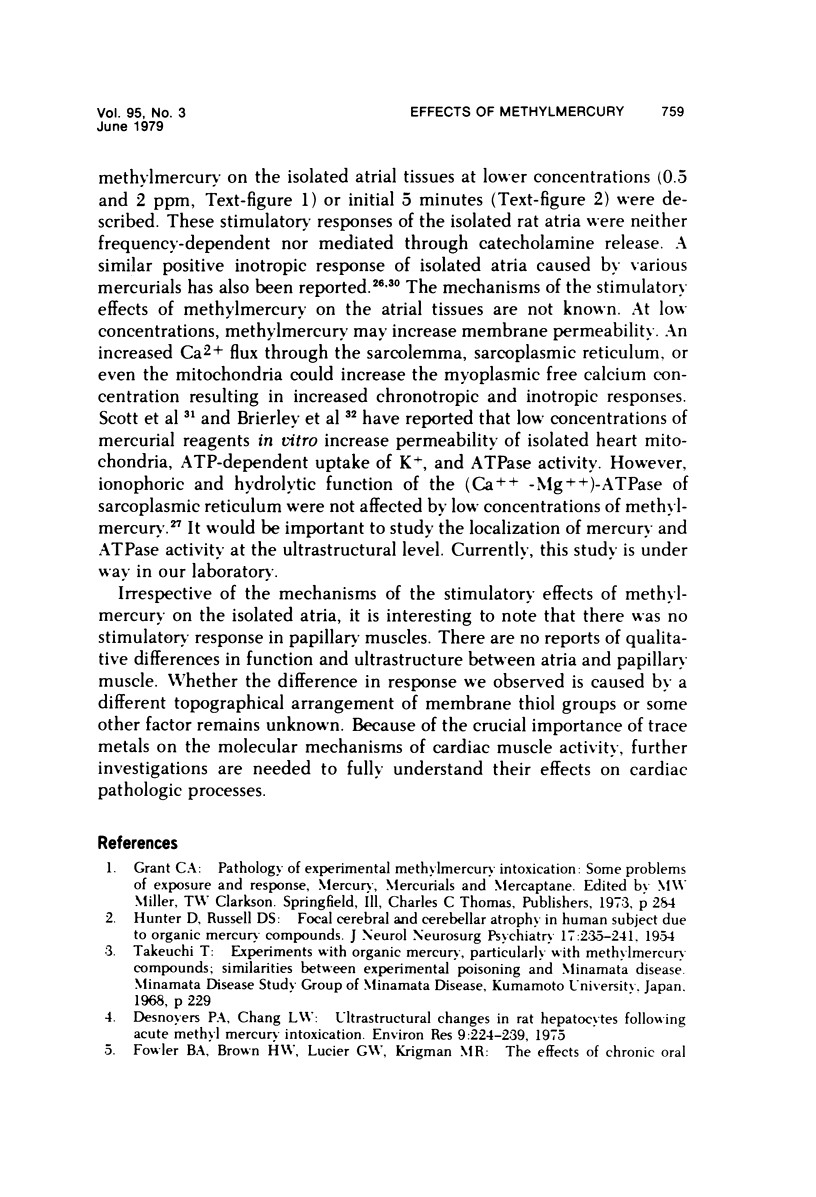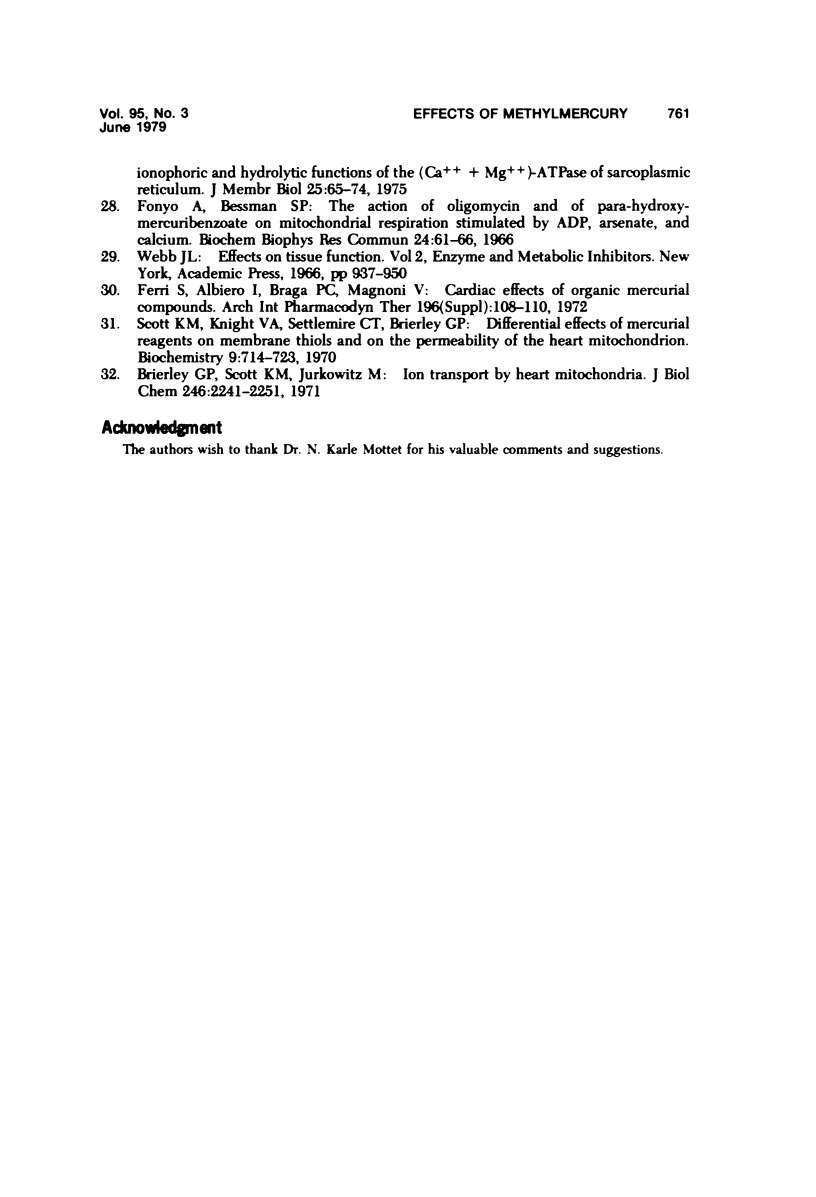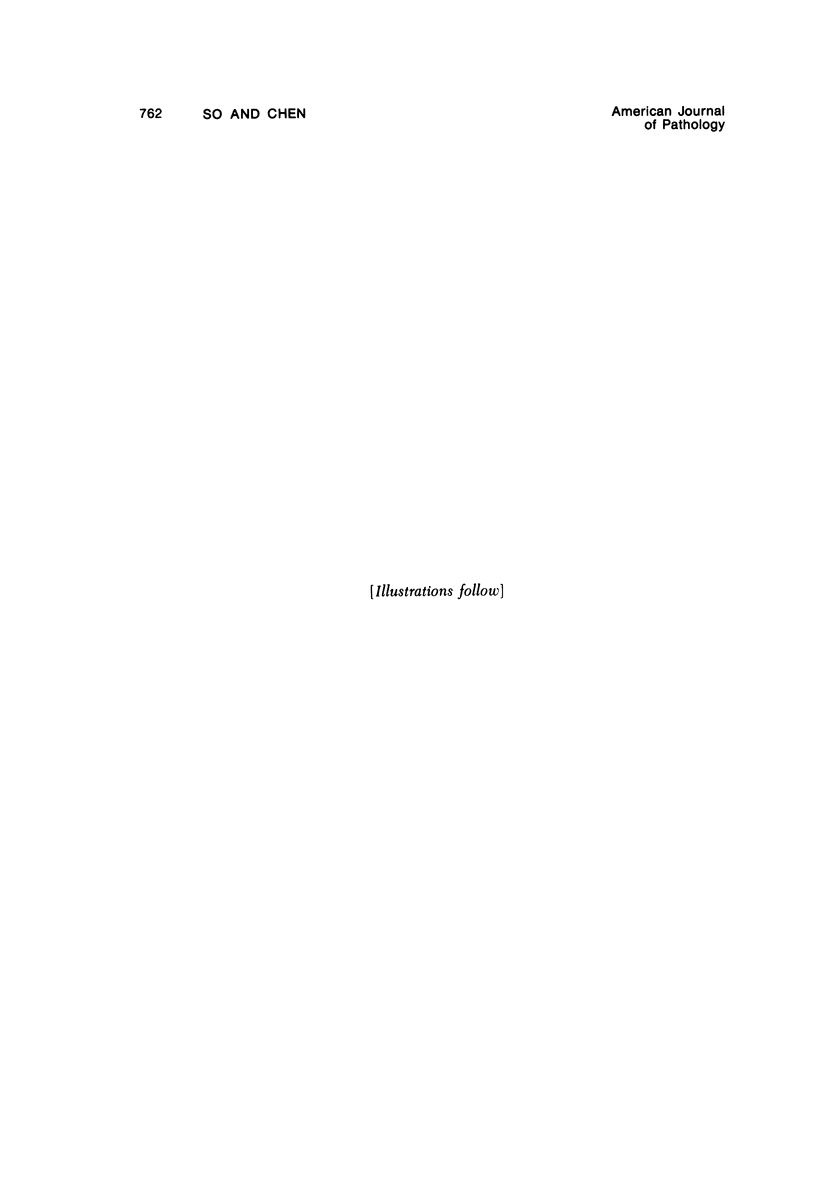Abstract
The effect of methylmercury hydroxide (MMH) on the frequency of spontaneously beating atrial-SA node and on the isometric tension of electrically stimulated left atrial (1 Hz) preparation isolated from rats were investigated. The tissues were also fixed for ultrastructural study at the end of the experiments. We found that MMH, at low doses (0.5 and 2ppm), increased the frequency of contractions and the isometric tension of isolated atria and decreased the isometric tension of isolated papillar muscles, and at higher doses (greater than 2ppm), decreased all the above parameter. Morphologically, there were dilation and swelling of mitochondrial and sarcoplasmic reticulum. Occasionally, deposits of amorphous material in the mitochondria and myofibrillary degeneration of myocardial fibers were noted. It is concluded the MMH has direct effect on intracellular organelles (mitochondria, sarcoplasmic reticulum, and myofibril) of myocardial tissue and induces functional changes of atria and papillary muscles
Full text
PDF











Images in this article
Selected References
These references are in PubMed. This may not be the complete list of references from this article.
- Blinks J. R. Convenient apparatus for recording contractions of isolated heart muscle. J Appl Physiol. 1965 Jul;20(4):755–757. doi: 10.1152/jappl.1965.20.4.755. [DOI] [PubMed] [Google Scholar]
- Bonenfant J. L., Auger C., Miller G., Chenard J., Roy P. E. Québec beer-drinkers' myocardosis: pathological aspects. Ann N Y Acad Sci. 1969 Jan 31;156(1):577–582. doi: 10.1111/j.1749-6632.1969.tb16752.x. [DOI] [PubMed] [Google Scholar]
- Bonenfant J. L., Miller G., Roy P. E. Quebec beer-drinkers' cardiomyopathy: pathological studies. Can Med Assoc J. 1967 Oct 7;97(15):910–916. [PMC free article] [PubMed] [Google Scholar]
- Brierley G. P., Scott K. M., Jurkowitz M. Ion transport by heart mitochondria. XXI. Differential effects of mercurial reagents on adenosine triphosphatase activity and on adenosine triphosphate-dependent swelling and contraction. J Biol Chem. 1971 Apr 10;246(7):2241–2251. [PubMed] [Google Scholar]
- Desnoyers P. A., Chang L. W. Ultrastructural changes in rat hepatocytes following acute methyl mercury intoxication. Environ Res. 1975 Jun;9(3):224–239. doi: 10.1016/0013-9351(75)90003-1. [DOI] [PubMed] [Google Scholar]
- Endo M. Calcium release from the sarcoplasmic reticulum. Physiol Rev. 1977 Jan;57(1):71–108. doi: 10.1152/physrev.1977.57.1.71. [DOI] [PubMed] [Google Scholar]
- Ferri S., Albiero L., Braga P. C., Vagnoni V. Cardiac effects of organic mercurial compounds. Arch Int Pharmacodyn Ther. 1972 Apr;196(Suppl):108–108. [PubMed] [Google Scholar]
- Fonyo A., Bessman S. P. The action of oligomycin and of para-hydroxymercuribenzoate on mitochondrial respiration stimulated by ADP, arsenate and calcium. Biochem Biophys Res Commun. 1966 Jul 6;24(1):61–66. doi: 10.1016/0006-291x(66)90410-4. [DOI] [PubMed] [Google Scholar]
- Grice H. C., Goodman T., Munro I. C., Wiberg G. S., Morrison A. B. Myocardial toxicity of cobalt in the rat. Ann N Y Acad Sci. 1969 Jan 31;156(1):189–194. doi: 10.1111/j.1749-6632.1969.tb16727.x. [DOI] [PubMed] [Google Scholar]
- HUNTER D., RUSSELL D. S. Focal cerebellar and cerebellar atrophy in a human subject due to organic mercury compounds. J Neurol Neurosurg Psychiatry. 1954 Nov;17(4):235–241. doi: 10.1136/jnnp.17.4.235. [DOI] [PMC free article] [PubMed] [Google Scholar]
- KLINE T. S. Myocardial changes in lead poisoning. AMA J Dis Child. 1960 Jan;99:48–54. doi: 10.1001/archpedi.1960.02070030050009. [DOI] [PubMed] [Google Scholar]
- Khan M. Y., Buse M., Louria D. B. Lead cardiomyopathy in mice: a correlative ultrastructural and blood level study. Arch Pathol Lab Med. 1977 Feb;101(2):89–94. [PubMed] [Google Scholar]
- Klein R., Herman S. P., Bullock B. C., Talley F. A. Methyl mercury intoxication in rat kidneys. Functional and pathological changes. Arch Pathol. 1973 Aug;96(2):83–90. [PubMed] [Google Scholar]
- MYERSON R. M., EISENHAUER J. H. Atrioventricular conduction defects in lead poisoning. Am J Cardiol. 1963 Mar;11:409–412. doi: 10.1016/0002-9149(63)90138-3. [DOI] [PubMed] [Google Scholar]
- Mottet N. K., Body R. L. Primate paneth cell degeneration following methylmercury hydroxide ingestion. Am J Pathol. 1976 Jul;84(1):93–110. [PMC free article] [PubMed] [Google Scholar]
- Perry H. M., Jr, Erlanger M. Hypertension and tissue metal levels after intraperitoneal cadmium, mercury, and zinc. Am J Physiol. 1971 Mar;220(3):808–811. doi: 10.1152/ajplegacy.1971.220.3.808. [DOI] [PubMed] [Google Scholar]
- Perry H. M., Jr, Erlanger M., Yunice A., Perry E. F. Mechanisms of the acute hypertensive effect of intra-arterial cadmium and mercury in anesthetized rats. J Lab Clin Med. 1967 Dec;70(6):963–972. [PubMed] [Google Scholar]
- Schmidt H., Harzmann R. Humanpathologische und tierexperimentelle Beobachtungen nach Intoxikation mit einer organischen Quecksilberverbindung ("Fusariol") Int Arch Arbeitsmed. 1970;26(1):71–83. [PubMed] [Google Scholar]
- Scott K. M., Knight V. A., Settlemire C. T., Brierley G. P. Differential effects of mercurial reagents on membrane thiols and on the permeability of the heart mitochondrion. Biochemistry. 1970 Feb 17;9(4):714–724. doi: 10.1021/bi00806a003. [DOI] [PubMed] [Google Scholar]
- Temma K., Akera T., Ku D. D., Brody T. M. Sodium pump inhibition by sulfhydryl inhibitors and myocardial contractility. Naunyn Schmiedebergs Arch Pharmacol. 1978 Mar;302(1):63–71. doi: 10.1007/BF00586599. [DOI] [PubMed] [Google Scholar]
- Tomlinson C. W., Yates J. C., Dhalla N. S. Relationship among changes in intracellular calcium stores, ultrastructure, and contractility of myocardium. Recent Adv Stud Cardiac Struct Metab. 1974;4:331–345. [PubMed] [Google Scholar]








